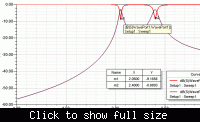a&f_hfss
Newbie level 4

hfss + microstrip filter design
here is my filter working in 2GHz.
But i have a problem on it. I simulated it in HFSS with two same models, i found their resultes are different. in one, the two resonators can coupled as shown

the other can not coupled.

I realised it, the results more close with the uncoupled one.

i am sure the radiation boundary (300/(1.5*4)) and solution frequency 2.0GHz are the same in this two models.
what is the problem? How can i obtain a 2GHz bandwidth as a bandpass filter with this structure?
Thanks everyone!
here is my filter working in 2GHz.
But i have a problem on it. I simulated it in HFSS with two same models, i found their resultes are different. in one, the two resonators can coupled as shown

the other can not coupled.

I realised it, the results more close with the uncoupled one.

i am sure the radiation boundary (300/(1.5*4)) and solution frequency 2.0GHz are the same in this two models.
what is the problem? How can i obtain a 2GHz bandwidth as a bandpass filter with this structure?
Thanks everyone!

